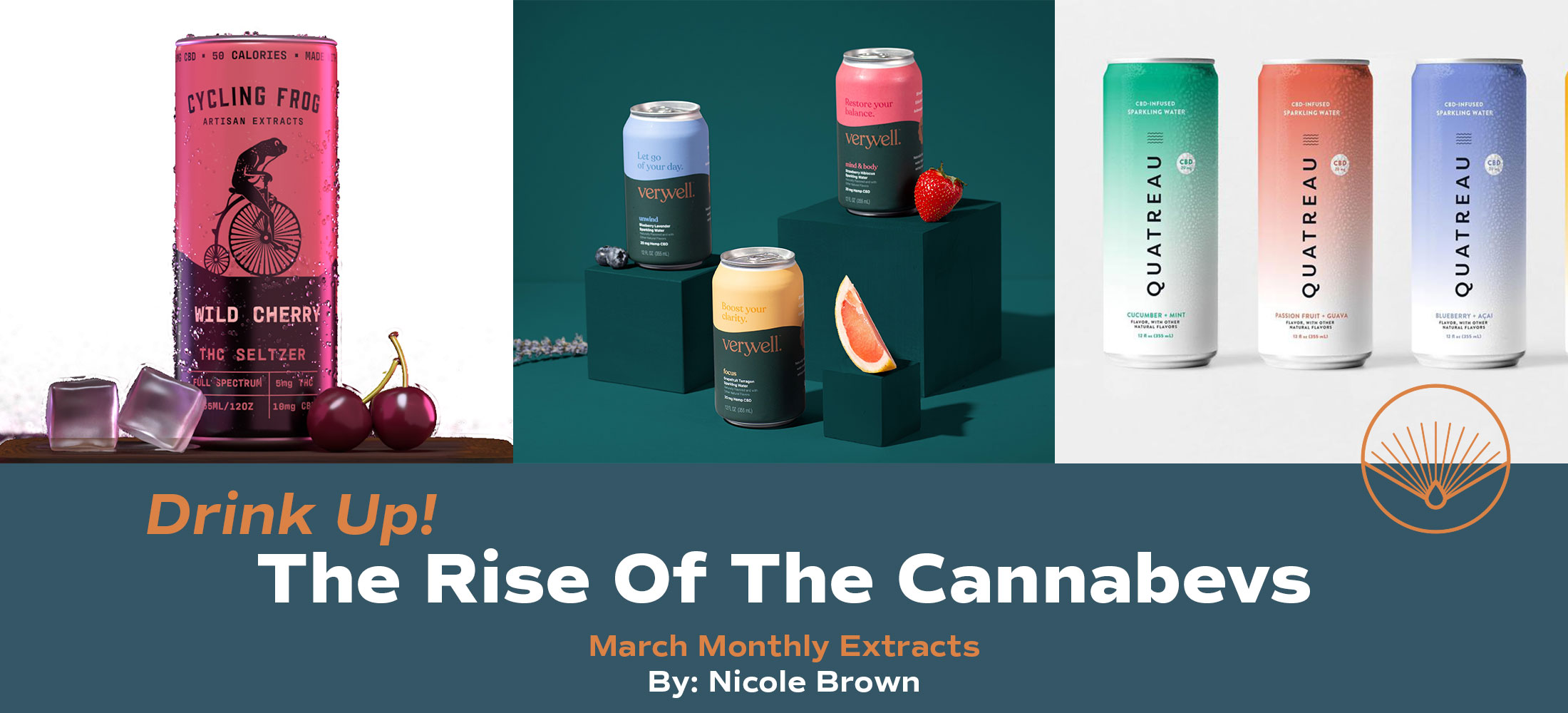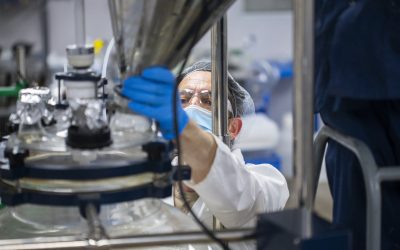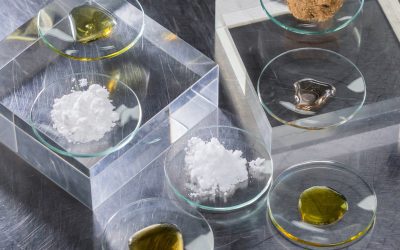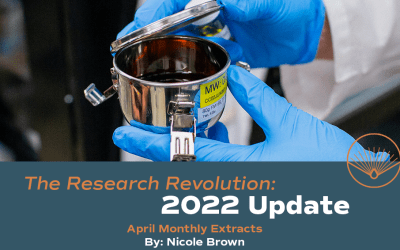Author: Nicole Brown
March 8, 2022 – 10 min read
Two years ago, the internet declared 2019 “White Claw summer,” with consumers so obsessed that they caused a shortage. But now, spiked-seltzer sales are coming down from their highs, and there’s shelf space for new functional and buzz-inducing drinks. Enter: cannabis beverages.
According to Brightfield Group research agency, THC-infused beverages will account for $1 billion in US sales by 2025. Sales of CBD drinks, which are available on a wider scale and in places where cannabis is not yet regulated, are expected to hit $2.5 billion.
CBD’s High Potential
Rapid change is the nature of the beverage industry. Thirty years ago, bottled water was inconceivable. Ten years ago, alcohol seltzers were mostly unheard of. Five years ago, CBD wasn’t on anyone’s radar. Today, we’re seeing a growing sober-curious movement that is normalizing an alcohol-free lifestyle and a culture that is increasingly perceiving hemp and cannabis as healthy alternatives.
Many beverage experts are expecting the CBD beverage category to continue to expand. Not only have consumers realized that their alcohol consumption has increased and needs to be dialed back, but they have also spent more time online, getting educated on new ingredient trends such as CBD, CBG, CBN, and THCV, and the benefits that these cannabinoids can deliver to the body.
“A growing number of consumers are moving away from, or at least lessening, their consumption of alcohol, which has raised an interest in alternative options, including Cannabis-infused beverages (CIBs),” explains Lori Hatcher, the head of marketing for Truss Beverage Co, a Canadian cannabis leader. “In our focus group, we learned that one of the biggest appeals to CIBs was the absence of negative components that are common in alcoholic beverages, like sugar and artificial flavors.”
The CBD beverage growth is likely to continue. In its May 2021 U.S. CBD Report, market research firm Brightfield Group estimated CBD-infused beverages took up about 5% of the total CBD product market share but were expected to be the fastest-growing CBD product type in 2021. Brightfield estimated the segment would experience year-over-year growth of 71%, as well as a compound annual growth rate of 51% between 2021 and 2026.
In Drizly’s annual report, the e-commerce platform notes that retailers are “very bullish” about cannabis- and CBD-infused products. Over 50% of retailers surveyed believed that cannabis- and CBD-infused beverages have the industry’s biggest growth potential.
This year, CBD companies have rushed into the beverage market with a variety of different products (even despite CBD in beverages still effectively considered illegal on a federal level by the FDA). Canopy Growth Corp. is one company that sees potential in the segment. In October, the company partnered with Karma Water to launch CBD water, which is made with Canopy’s broad spectrum CBD distillate derived from U.S. hemp biomass.
Earlier this year, the company also released a line of flavored CBD sparkling water under the Quatreau brand.
“The North American market potential for CBD-infused beverages is extremely promising, and with the continued growth the industry is seeing, we know it has the potential to really disrupt other traditional beverage formats, from sparkling water and soda to beer, wine and spirits,” shared Tara Rozalowsky, Canopy’s vice president of beverages and edibles. Rozalowsky went on to call the CBD beverage category “one of the fastest-growing and high-potential sectors in our industry.”
Curaleaf Holdings Inc. also announced in November that it signed a national distribution agreement with Southern Glazer’s Wine & Spirits to introduce “new innovations to both ancillary lines with confections and beverages that feature minor cannabinoids like CBN and CBG,” according to a press release.
Commercial Areas of Opportunity
To even approach the same levels of market share, cannabis beverage makers need to understand the gaps and how to bridge them. Consumer sentiment is often the main driver in new category creation, and the same holds true for the burgeoning cannabev category.
In the current market, there are four major areas of opportunity driven by consumer sentiment that makers should consider.
- Alcohol drinkers are becoming more mindful of the impact alcohol has on their health and well-being and seeking alternative ways to relax or socialize.
- New consumers are curious about or easing into the cannabis category but are intimidated by the stereotypical act of lighting up and/or playing the guessing game with edibles effects.
- Existing cannabis consumers are seeking a way to complement their existing consumption preferences or to replace traditional smoking habits.
- People sensitive to the effects of alcohol no longer want to feel hungover but still want a sessionable experience with friends that allows them the social and physical benefits.
Once makers have a grasp on the consumer insights that are driving growth in the beverage category, they can begin to consider the unique market opportunities that work in their favor.
- Wider beverage market and beer sales are in a slump. For the past several years, growth within the larger beverage category has stagnated, pushing many manufacturers to invest heavily in R&D within new markets. Alcohol replacement with a cannabis beverage is one of the biggest market opportunities, which is why major beer companies and brewers such as Molson Coors, Heineken and Pabst are diving into the space.
- THC product popularity is growing. 18 states have now legalized recreational use, creating a $28 billion cannabis market. Specifically, growth in the cannabis-infused beverage category was up by 22% year-over-year in 2020 versus 2019, and 57% of those who do consume cannabis beverages in the U.S. are consuming them at least weekly.
- New technology is creating faster onset and better absorption. Cannabevs offer advantages that other popular segments such as edibles and gummies don’t. The body has to digest edibles in order to access the active ingredients, but with a cannabev, the onset, absorption and bioavailability is much quicker and more effective. This helps prevent the common misadventure of inexperienced consumers taking an edible, not feeling the effect right away, growing impatient, taking another – and over consuming.
- Cannabis has a broader range of health benefits. Any kind of function or attribute a beverage maker might want to work with is available from medicinal to nutritional. Unlike alcohol, cannabevs can deliver different terpenes and nutraceuticals, offering an array of beneficial effects on the nervous system, the immune system and the metabolic system all at once.
- Potential manufacturing advantages. A 12-ounce can of beer contains only 2 ounces of alcohol, but you can’t shrink it or make it into a concentrate and follow the lucrative Coke and Pepsi model of shipping concentrate to a manufacturing facility. However, when federal legalization happens, CBD- or THC-infused beverage manufacturers would be able to take advantage of this model, shipping their concentrate to existing facilities that already make carbonated beverages. With the recent decline in carbonated beverage and beer sales, it’s reasonable to assume that these facilities would be relatively underutilized, creating an opportunity to step in and take advantage of production availability.
Consumer Trends in Cannabevs
According to market research firm Brightfield Group, consumers are looking to CBD drinks for numerous reasons or occasions, from functional and fun beverages for wellness and as alcohol substitutes.
“With so many existing occasions and reasons to enjoy a drink, CBD beverage companies need to get creative and specific with their positionings,” said Brightfield Group’s Madeline Scanlon. “Whether casting a wide net or hooking a specific niche, the real catch is gaining loyal customers that come to you for a distinct purpose.”
Daily Routine
- In Q2 2021, 45% of CBD consumers report taking CBD daily, Brightfield Group reported. CBD drinks are a natural fit for this type of regular CBD consumer.
- “One of the barriers to entry for daily CBD use is price, and CBD drinks tend to have a higher price per dose than tinctures or gummies,” Scanlon said. “Enter drink mixes! CBD drink mixes are getting in the mix, offering familiar, affordable options for sipping CBD. Single-serving packets are easy to prepare, take up little space and are more pleasant than swallowing a pill or taking a drop of tincture to the tongue.”
Balance
- While there are numerous uses for CBD, “it can be hard to craft a product that delivers on that effect when CBD use can be so subtle — especially if the consumer is not consistently using CBD,” Scanlon noted. “So instead of overpromising on specific benefits, brands are finding a sweet spot highlighting CBD’s benefits for homeostasis.”
- While research is in its early stages, preliminary results show CBD — and other phytocannabinoids like CBG and THC — could help bodies stay in homeostasis, or “the self-regulating process by which an organism tends to maintain stability while adjusting to conditions that are best for its survival.”
Alcohol Replacement
- According to Brightfield Group’s Alcohol Trends and Non-Alcoholic Trends reports, consumers are drinking less alcohol than they were pre-pandemic. New Evergi Consumers data also shows 60% of American alcohol consumers say they are using less alcohol than in the past.
- Of consumers who report drinking less, 11% say they are swapping alcohol with CBD drinks, according to Evergi Consumers data. With another 29% of these consumers substituting alcohol with “nothing,” there is still plenty of opportunity to position CBD as the perfect alcohol alternative.
- For a CBD drink to become a “non-alcoholic alternative,” it should be positioned among alcohol options, Scanlon noted.
- “As with all CBD categories, the competition will only continue to increase as new consumers discover CBD and regulations give the green light to big beverage companies,” said Scanlon. “Having the right data to back brand positioning paves the road to successful products that solve distinct consumer needs. But first, a brand must be able to answer — what is my CBD drink for?”
What’s Next?
Beverages are one of the fastest-growing parts of the cannabinoid industry, coupled with a massive overall trend towards functional beverages. People are thinking more about their health as part of their lifestyle. And with CBD, it’s a sign of the times: people are stressed, and they’re willing to invest in premium ingredients that support their cognitive wellness.
We’re currently in the early stages of the CBD beverage market, and regulatory approval is the impending catalyst that will drive profound growth. As states and the FDA move in the right direction, we are seeing more money allocated to the research around all of the cannabinoids in the hemp and cannabis space and different dosing protocols—especially micro-dosing and sophisticated formulations with precise ratios – and with more data comes more consumer awareness. Once consumers are more aware of the benefits of the plant in general and the individual cannabinoids, they will look to brands that they trust in the CBD space for new innovation.
Author: Nicole Brown
March 8, 2022 – 10 min read
Two years ago, the internet declared 2019 “White Claw summer,” with consumers so obsessed that they caused a shortage. But now, spiked-seltzer sales are coming down from their highs, and there’s shelf space for new functional and buzz-inducing drinks. Enter: cannabis beverages.
According to Brightfield Group research agency, THC-infused beverages will account for $1 billion in US sales by 2025. Sales of CBD drinks, which are available on a wider scale and in places where cannabis is not yet regulated, are expected to hit $2.5 billion.
CBD’s High Potential
Rapid change is the nature of the beverage industry. Thirty years ago, bottled water was inconceivable. Ten years ago, alcohol seltzers were mostly unheard of. Five years ago, CBD wasn’t on anyone’s radar. Today, we’re seeing a growing sober-curious movement that is normalizing an alcohol-free lifestyle and a culture that is increasingly perceiving hemp and cannabis as healthy alternatives.
Many beverage experts are expecting the CBD beverage category to continue to expand. Not only have consumers realized that their alcohol consumption has increased and needs to be dialed back, but they have also spent more time online, getting educated on new ingredient trends such as CBD, CBG, CBN, and THCV, and the benefits that these cannabinoids can deliver to the body.
“A growing number of consumers are moving away from, or at least lessening, their consumption of alcohol, which has raised an interest in alternative options, including Cannabis-infused beverages (CIBs),” explains Lori Hatcher, the head of marketing for Truss Beverage Co, a Canadian cannabis leader. “In our focus group, we learned that one of the biggest appeals to CIBs was the absence of negative components that are common in alcoholic beverages, like sugar and artificial flavors.”
The CBD beverage growth is likely to continue. In its May 2021 U.S. CBD Report, market research firm Brightfield Group estimated CBD-infused beverages took up about 5% of the total CBD product market share but were expected to be the fastest-growing CBD product type in 2021. Brightfield estimated the segment would experience year-over-year growth of 71%, as well as a compound annual growth rate of 51% between 2021 and 2026.
In Drizly’s annual report, the e-commerce platform notes that retailers are “very bullish” about cannabis- and CBD-infused products. Over 50% of retailers surveyed believed that cannabis- and CBD-infused beverages have the industry’s biggest growth potential.
This year, CBD companies have rushed into the beverage market with a variety of different products (even despite CBD in beverages still effectively considered illegal on a federal level by the FDA). Canopy Growth Corp. is one company that sees potential in the segment. In October, the company partnered with Karma Water to launch CBD water, which is made with Canopy’s broad spectrum CBD distillate derived from U.S. hemp biomass.
Earlier this year, the company also released a line of flavored CBD sparkling water under the Quatreau brand.
“The North American market potential for CBD-infused beverages is extremely promising, and with the continued growth the industry is seeing, we know it has the potential to really disrupt other traditional beverage formats, from sparkling water and soda to beer, wine and spirits,” shared Tara Rozalowsky, Canopy’s vice president of beverages and edibles. Rozalowsky went on to call the CBD beverage category “one of the fastest-growing and high-potential sectors in our industry.”
Curaleaf Holdings Inc. also announced in November that it signed a national distribution agreement with Southern Glazer’s Wine & Spirits to introduce “new innovations to both ancillary lines with confections and beverages that feature minor cannabinoids like CBN and CBG,” according to a press release.
Commercial Areas of Opportunity
To even approach the same levels of market share, cannabis beverage makers need to understand the gaps and how to bridge them. Consumer sentiment is often the main driver in new category creation, and the same holds true for the burgeoning cannabev category.
In the current market, there are four major areas of opportunity driven by consumer sentiment that makers should consider.
- Alcohol drinkers are becoming more mindful of the impact alcohol has on their health and well-being and seeking alternative ways to relax or socialize.
- New consumers are curious about or easing into the cannabis category but are intimidated by the stereotypical act of lighting up and/or playing the guessing game with edibles effects.
- Existing cannabis consumers are seeking a way to complement their existing consumption preferences or to replace traditional smoking habits.
- People sensitive to the effects of alcohol no longer want to feel hungover but still want a sessionable experience with friends that allows them the social and physical benefits.
Once makers have a grasp on the consumer insights that are driving growth in the beverage category, they can begin to consider the unique market opportunities that work in their favor.
- Wider beverage market and beer sales are in a slump. For the past several years, growth within the larger beverage category has stagnated, pushing many manufacturers to invest heavily in R&D within new markets. Alcohol replacement with a cannabis beverage is one of the biggest market opportunities, which is why major beer companies and brewers such as Molson Coors, Heineken and Pabst are diving into the space.
- THC product popularity is growing. 18 states have now legalized recreational use, creating a $28 billion cannabis market. Specifically, growth in the cannabis-infused beverage category was up by 22% year-over-year in 2020 versus 2019, and 57% of those who do consume cannabis beverages in the U.S. are consuming them at least weekly.
- New technology is creating faster onset and better absorption. Cannabevs offer advantages that other popular segments such as edibles and gummies don’t. The body has to digest edibles in order to access the active ingredients, but with a cannabev, the onset, absorption and bioavailability is much quicker and more effective. This helps prevent the common misadventure of inexperienced consumers taking an edible, not feeling the effect right away, growing impatient, taking another – and over consuming.
- Cannabis has a broader range of health benefits. Any kind of function or attribute a beverage maker might want to work with is available from medicinal to nutritional. Unlike alcohol, cannabevs can deliver different terpenes and nutraceuticals, offering an array of beneficial effects on the nervous system, the immune system and the metabolic system all at once.
- Potential manufacturing advantages. A 12-ounce can of beer contains only 2 ounces of alcohol, but you can’t shrink it or make it into a concentrate and follow the lucrative Coke and Pepsi model of shipping concentrate to a manufacturing facility. However, when federal legalization happens, CBD- or THC-infused beverage manufacturers would be able to take advantage of this model, shipping their concentrate to existing facilities that already make carbonated beverages. With the recent decline in carbonated beverage and beer sales, it’s reasonable to assume that these facilities would be relatively underutilized, creating an opportunity to step in and take advantage of production availability.
Consumer Trends in Cannabevs
According to market research firm Brightfield Group, consumers are looking to CBD drinks for numerous reasons or occasions, from functional and fun beverages for wellness and as alcohol substitutes.
“With so many existing occasions and reasons to enjoy a drink, CBD beverage companies need to get creative and specific with their positionings,” said Brightfield Group’s Madeline Scanlon. “Whether casting a wide net or hooking a specific niche, the real catch is gaining loyal customers that come to you for a distinct purpose.”
Daily Routine
- In Q2 2021, 45% of CBD consumers report taking CBD daily, Brightfield Group reported. CBD drinks are a natural fit for this type of regular CBD consumer.
- “One of the barriers to entry for daily CBD use is price, and CBD drinks tend to have a higher price per dose than tinctures or gummies,” Scanlon said. “Enter drink mixes! CBD drink mixes are getting in the mix, offering familiar, affordable options for sipping CBD. Single-serving packets are easy to prepare, take up little space and are more pleasant than swallowing a pill or taking a drop of tincture to the tongue.”
Balance
- While there are numerous uses for CBD, “it can be hard to craft a product that delivers on that effect when CBD use can be so subtle — especially if the consumer is not consistently using CBD,” Scanlon noted. “So instead of overpromising on specific benefits, brands are finding a sweet spot highlighting CBD’s benefits for homeostasis.”
- While research is in its early stages, preliminary results show CBD — and other phytocannabinoids like CBG and THC — could help bodies stay in homeostasis, or “the self-regulating process by which an organism tends to maintain stability while adjusting to conditions that are best for its survival.”
Alcohol Replacement
- According to Brightfield Group’s Alcohol Trends and Non-Alcoholic Trends reports, consumers are drinking less alcohol than they were pre-pandemic. New Evergi Consumers data also shows 60% of American alcohol consumers say they are using less alcohol than in the past.
- Of consumers who report drinking less, 11% say they are swapping alcohol with CBD drinks, according to Evergi Consumers data. With another 29% of these consumers substituting alcohol with “nothing,” there is still plenty of opportunity to position CBD as the perfect alcohol alternative.
- For a CBD drink to become a “non-alcoholic alternative,” it should be positioned among alcohol options, Scanlon noted.
- “As with all CBD categories, the competition will only continue to increase as new consumers discover CBD and regulations give the green light to big beverage companies,” said Scanlon. “Having the right data to back brand positioning paves the road to successful products that solve distinct consumer needs. But first, a brand must be able to answer — what is my CBD drink for?”
What’s Next?
Beverages are one of the fastest-growing parts of the cannabinoid industry, coupled with a massive overall trend towards functional beverages. People are thinking more about their health as part of their lifestyle. And with CBD, it’s a sign of the times: people are stressed, and they’re willing to invest in premium ingredients that support their cognitive wellness.
We’re currently in the early stages of the CBD beverage market, and regulatory approval is the impending catalyst that will drive profound growth. As states and the FDA move in the right direction, we are seeing more money allocated to the research around all of the cannabinoids in the hemp and cannabis space and different dosing protocols—especially micro-dosing and sophisticated formulations with precise ratios – and with more data comes more consumer awareness. Once consumers are more aware of the benefits of the plant in general and the individual cannabinoids, they will look to brands that they trust in the CBD space for new innovation.




